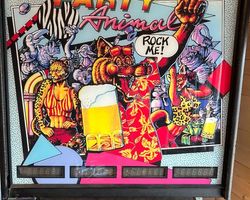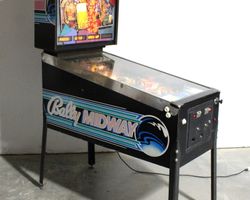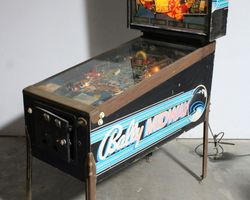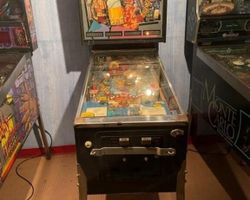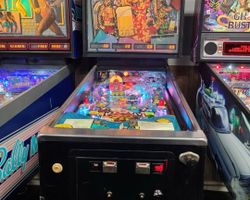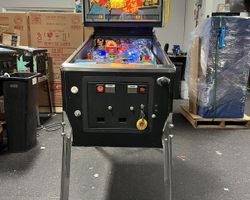Party Animal
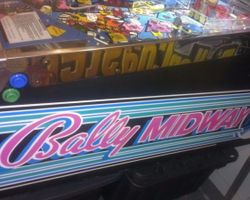
Average Prices: USD $400 to $1,100
Produced: May, 1987
Production Run: 2,250 units
Machine Type: Solid State Electronic
MPU: Bally MPU A084-91786-AH06 (6803)
Players: 4
Design by: Dennis Nordman
Art by: Pat McMahon
Sound by: Michael Bartlow
Software by: Rehman Merchant
"Party Animal," a solid-state electronic pinball machine released in May 1987 by Bally Manufacturing Co., represents a distinctive slice of late 1980s pinball design. With a production run of 2,250 units, it emerged from an era where pinball manufacturers were actively exploring new themes and interactive features to capture player attention. The machine's concept revolves around a lively, anthropomorphic animal party, a playful and somewhat irreverent theme that aligned with the lighthearted sensibilities of the time.
The creative forces behind "Party Animal" included a team of notable contributors. Dennis Nordman, known for his ability to infuse machines with personality and distinctive layouts, handled the design. His approach often favored imaginative playfield elements and a strong thematic presence. Pat McMahon was responsible for the artwork, crafting the vibrant and amusing caricatures of party-going animals that define the machine's visual identity. Rehman Merchant developed the software, ensuring the game's rules and interactions functioned as intended, while M. Bartlow contributed to the sound design, a particularly noteworthy aspect of this machine. One unique piece of trivia associated with "Party Animal" is the existence of two distinct translite versions: a "bar" version depicting a plain beer stein and a "home" version featuring the words "Dad's Old Fashioned Root Beer" on the stein, a subtle alteration for different distribution channels. Furthermore, "Party Animal" holds a curious distinction as one of the earliest, if not the first, pinball games to incorporate the sounds of a belch and a flushing toilet into its auditory experience, a testament to the era's evolving sense of humor and sound design experimentation in arcades.
Signature Features and Design
"Party Animal" distinguishes itself through several interactive elements and its vibrant thematic presentation. Central to the playfield is the Jukebox, a prominent toy that allows players to change the background music by hitting specific targets. This feature cycles through eight different party anthems, dynamically altering the auditory backdrop of the game and providing a tangible reward for target accuracy. The Jukebox's presence enhances the party theme, making players feel more engaged with the playful atmosphere.
Another standout interactive toy is the Jumping Toad. Positioned on a toadstool, this amphibian character reacts physically, jumping when struck by the pinball. This kinetic element adds a layer of visual feedback and charm, breaking up the static nature of typical playfield toys and further immersing players in the whimsical animal party.
The machine's sound design, executed on the 68000-based "Sounds Deluxe" sound board, is a core component of its identity. Beyond the innovative belch and flushing toilet sounds, "Party Animal" features custom speech callouts such as "How ya doin'?" and "Get lost, jerk!", delivered with a distinctive 1980s vocal flair. The frog's "ribbit" sound, specifically, contributes to the game's comedic tone. These auditory cues, combined with the changing music from the Jukebox, create a lively and often humorous soundscape that keeps the player engaged. Pat McMahon's artwork supports this, adorning the playfield with caricatured animals engaged in various party antics, from a lounging walrus to a beer-chugging wolf. While the cabinet art itself is often described as plain compared to the playfield, the overall visual and auditory package successfully communicates the machine's "Party at the Zoo" or "Cheesy 80s Frat Party" theme.
Playfield and Mechanics
The "Party Animal" playfield layout is designed to facilitate a flow that encourages both precision shots and chaotic action, characteristic of many Bally machines from the era. It features a traditional three-flipper setup: two at the bottom and a crucial third upper flipper positioned to access the upper playfield elements. Three pop bumpers occupy a central-upper position, designed to create unpredictable ball movement and score rapid points. Two slingshots guard the outlanes, providing reactive deflection to errant shots.
Key targets on the playfield include three kick-out holes that collect the ball and deliver specific rewards or initiate events. Two ramps are present, offering valuable shots that loop the ball back to the flippers or feed specific areas. These ramps, while providing clear shot paths, have been noted for their construction, sometimes described as thin or prone to cracking. A set of three in-line drop targets provides a satisfying challenge, requiring successive hits to clear and often leading to higher scoring opportunities or activating features.
The design philosophy behind the layout centers on creating an approachable yet engaging experience. The manual plunger shot leads directly into a ball trap, providing a controlled start to each ball. While the overall flow is often described as decent, some players have noted occasional clunkiness or frustrating drains on the outer lanes, particularly from the upper kickout. Despite these minor quirks, the arrangement of targets, ramps, and interactive toys like the Jukebox and Jumping Toad ensures a diverse range of shots and encourages exploration of the playfield. The artwork integrates seamlessly with the layout, with various animal characters pointing to shot opportunities and reinforcing the overarching party aesthetic through vibrant colors and dynamic illustrations.
Gameplay Dynamics
"Party Animal" offers gameplay dynamics that are straightforward enough for casual players to grasp quickly, yet possess sufficient depth to encourage repeated play. The scoring system is displayed on an alphanumeric display, tracking player progress as they hit various targets and achieve objectives. The core progression often revolves around lighting up letters for "Surprise Party," a cumulative objective that, once completed, typically leads to the lucrative three-ball multiball mode.
Achieving multiball is a primary objective, and while some players find it challenging to initiate consistently, the difficulty adds to the satisfaction when it finally launches. During multiball, players aim to keep multiple balls in play simultaneously, maximizing scoring potential through rapid-fire shots. Beyond multiball, unique objectives are tied to the interactive toys. Hitting the Jukebox targets to change songs provides both an auditory reward and often contributes to scoring, encouraging players to aim for this central feature. Striking the Jumping Toad also provides points and visual feedback, adding another layer to the strategic decision-making on the playfield.
Strategies often involve prioritizing the in-line drop targets, as clearing these can lead to significant points or open up new scoring paths. The upper flipper is crucial for accessing certain ramp shots or targets that are difficult to reach from the main flippers. The game's design, with its relatively clear shots and understandable rules, fosters an environment where players feel they can always achieve "just one more game," aiming to trigger the multiball or improve their high score. The unique sounds and callouts serve as ongoing motivators, with the unexpected belch or flushing toilet sound providing moments of levity throughout the game.
Reception and Legacy
"Party Animal" has garnered a generally positive, albeit not universally effusive, reception within the pinball community. Its strengths are frequently cited, beginning with its distinctive and often amusing "cheesy 80s frat party" or "party at the zoo" theme. Players often commend the unique Jukebox feature, allowing them to cycle through songs, and the overall engaging audio package, including the custom speech and humorous sound effects like the belch and toilet flush. The machine is commonly recommended for casual players or newcomers to pinball due to its accessible rules and easily understandable shots, making it a good choice for those seeking a lighter, fun experience. Despite its relative simplicity, many find it possesses a strong "one more time" factor, drawing them back for another attempt at reaching multiball or improving their score. For collectors, it's sometimes viewed as a good value option to round out a diverse collection.
However, "Party Animal" is not without its criticisms. While many appreciate the audio, some players find the sounds and music repetitive over extended play sessions. The cabinet art is frequently described as plain, generic, or dated, contrasting with the more animated playfield visuals. Concerns regarding build quality have also surfaced, with some reporting flimsy plastics, thin ramps, or flipper issues that may require adjustment or rebuilding to perform optimally. Ball flow is another point of contention; some players perceive the game as clunky or experience frustrating drains from the outer lanes or upper kickout. The multiball mode, while rewarding to achieve, is often noted as difficult to start, which can be a point of frustration for some, though others view this as adding to the challenge. The "dated 80s" theme, while a positive for many, can be a turn-off for others who find it hasn't aged well.
Despite these mixed views, "Party Animal" holds a place in pinball history as a representative machine from the Bally 6803 MPU generation of the late 1980s. It stands as an early example of Dennis Nordman's design sensibility, even if it predates some of his more celebrated titles. Its pioneering inclusion of certain humorous sound effects marked a small, yet notable, step in pinball's evolving sound design. The Jukebox feature, allowing player interaction to change the in-game music, was an innovative concept for its time, hinting at future interactive elements in pinball playfields. While it may not command the same high regard as some of its contemporaries or later machines, "Party Animal" remains a memorable and often enjoyable entry for those who appreciate its unique theme and unpretentious gameplay.
Sponsored Links
 Ebay Listings
Ebay Listings
 Auction Results
Auction Results
| Cost | Location | Date |
|---|---|---|
| GBP £1,307 |  Carnoustie, United Kingdom Carnoustie, United Kingdom |
15 July, 2025 |
| USD $3,489 |  Florida, United States Florida, United States |
03 November, 2024 |
| USD $1,300 |  Maryland, United States Maryland, United States |
18 January, 2024 |
| USD $3,000 |  Florida, United States Florida, United States |
05 September, 2023 |
| USD $1,500 |  Pennsylvania, United States Pennsylvania, United States |
14 January, 2023 |
| USD $900 |  Maryland, United States Maryland, United States |
01 December, 2022 |
| CAD $1,850 |  Canada Canada |
24 November, 2022 |
| USD $2,500 |  Florida, United States Florida, United States |
25 May, 2022 |
| USD $700 |  Oklahoma, United States Oklahoma, United States |
26 April, 2022 |
| USD $1,225 |  Florida, United States Florida, United States |
20 September, 2021 |


Private Policy · Search Website · Contact Us
As an eBay Partner, we may earn a commission from qualifying purchases made through links on this site, at no additional cost to you.
All trademarks and copyrighted materials remain property of their respective owners. All other content copyright 2007 - 2026 Pinpedia.

